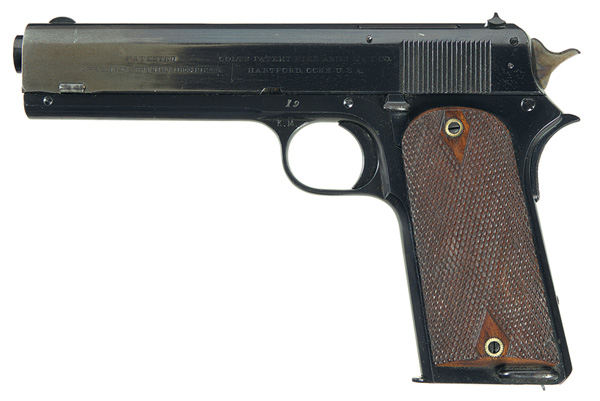
The ergonomics of the pistol were exemplary, especially when you consider that the field of ergonomics was still in its infancy. The grip angle had been changed from that of the the M-1900-1905 series, to one more in keeping with the shooter’s wrist angle. The combined thumb and grip safeties were well-positioned, easy to use, and natural in movement.
In 1911, Colt only knew one way to make handguns: the right way. Their handguns were objects of art, the pinnacle of the craftsman’s skill. Each military 1911 pistol was given the same care their commercial pistols would have received.
The parts were made from forgings, machined with care and hand-fitted. Once fitted, they were turned over to the polishing crew, who took great care to buff each of them to a mirror finish, without blurring rollmarks or knocking off edges. Then the pistols went off for blueing. In 1936 Colt wrote a book, A Century of Progress, that extolled their products. Not much had changed between 1911 and 1936. Their blueing procedure had changed, but not much.

Once buffed, each pistol was dunked in oil to protect the finish. Once a rack of pistols was ready, they were degreased and placed in the blueing ovens. Yes, ovens. But wait, it gets better. The degreasing process consisted of vats of boiling gasoline. The ovens were charcoal-fired for a while, then changed to gas ovens during WWI. They ran at a temperature between 610° and 670° F. The base of the ovens had a layer of bone charcoal and oil, to provide a small amount of carbon to the process.
The pistols rotated in the oven for five hours, slowing blueing as they spun. The result is a finish that cannot be duplicated by modern processes. The surface polish is so unmarred that the finish seems to have depth. The blueing has a color and clarity unmatched by modern hot chemical dip blueing. The finish is so deep, nearly three-dimensional, that it’s difficult to reproduce in photographs.
It also was not as durable as the Army liked. The bright polish showed scratches, and the blueing wore too easily. Remember, in 1911-12 the US army was not just a barracks force, they had units in the jungle in the Philippines and Cuba; the Marines had units on naval vessels; and the Navy was buying pistols for their own use. So, at about serial number 2400, Colt changed the polishing process. They had the crews stop a polishing grit sooner, and the duller finish (which is still a high-gloss finish by today’s standards) was “good enough.”
The pistols were marked on the slide “Model of 1911 US Army” except for those sent to the Navy, after Naval adoption in 1913; these had “Model of 1911 US Navy” markings instead. There were plans to mark the ones meant for the Marine Corps with “Model of 1911 USMC” but none were ever so marked. The Army simply issued the pistols and did not mark them with the unit of record, a habit beloved by European armies. Collectors of Lugers, for instance, go to great lengths to find unit-marked pistols, and track down just what the sometimes-cryptic markings mean. The US Navy, however, marked the pistols that went to ships, at least those that went to battleships. A 1911 with “BB” and a number indicates which battleship it went to, for example; this sort of thing provides a hot area for collectors.
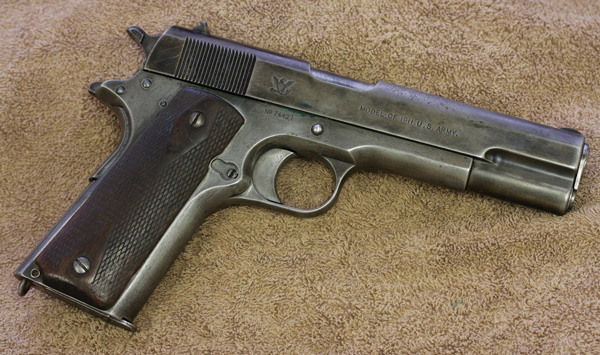
Along with the pistols made by Colt, the government required Colt to provide the government arsenal, Springfield, with drawings, tooling and assistance to provide pistols as well. In today’s logistical environment, where as much as possible is commercial, off-the-shelf (COTS) product, the idea that the government would have its own plant, to make its own pistols, is interesting. The accountants figured that they could make pistols there for about two-thirds the cost of the Colt pistols, and since they weren’t getting as much money as they needed from Congress (some things never change) the Army could get more pistols for less money, which was considered a good thing.
Alas, the project was nothing but a source of headaches. Colt sent the drawings, but drawings (especially back then) were only part of the story. It takes an experienced machine operator to produce parts and not scrap. And once a product is being made, the interplay between departments, supervisors and machine operators is the make-or-break difference. In the end, Springfield could not make 1911 pistols as fast or as economically as Colt.
The 1911 was also not available commercially early on, and when it became available, it wasn’t in sufficient quantity. Having gone to the trouble of testing, developing, and co-designing the pistol, the Army expected to be first in line for production.
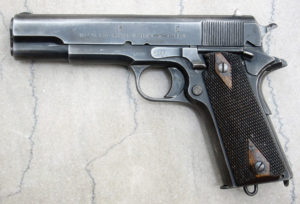
There was a small problem with the magazines. Today, we take sheet-metal pressings or stampings for granted. Heck, we make automobiles in their entirety from stampings. Except for things like engine blocks, transmissions and heavy structures (which are in most cases castings) your entire car can be an assembly of sheet metal stampings that are bent, folded, creased and welded. But in 1911, sheet metal pressings were a new thing. Magazines were a new thing. Magazine-fed rifles used machined rails as integral parts of their receivers, to guide each cartridge in turn to the chamber.
The magazine of a pistol could not be so built. It would be cost-prohibitive to make a near-disposable item like a magazine from machined parts. So they were stamped, folded and welded. (It would be a long time before impact extrusion was advanced enough, and cheap enough, to be used to form magazine tubes.)
If the magazine lips were too soft, they would bend under use. If they were too hard, they would crack. They had to be just right. Unfortunately, that wasn’t easy. Early on, the magazines were the weak link. A method of cyanide-hardening the lips of the magazine was developed, which produced a magazine that was two-tone.
The hardened part of it would stay bright and not take blueing. But the corners of the folds would be stress points, and the tubes would crack. So Colt designed magazines for a while that are known as “keyhole” mags. To give the lips enough flex to feed, but hardness enough to not bend, the spine of the magazine was punched, and a slot also stamped out from the hole upwards. That, combined with a radius on the clearance slot to reduce stress, produced a magazine that was hard but had flex.
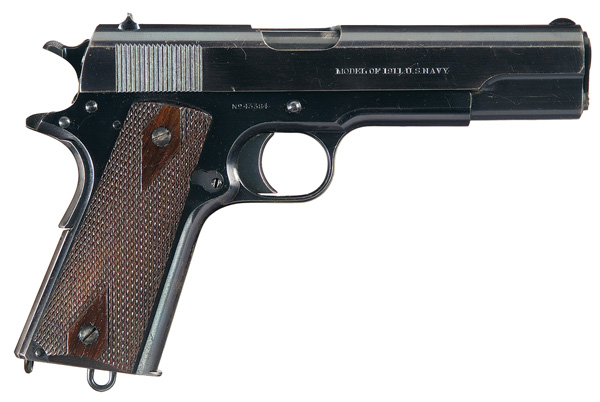
With a real problem on their hands and an interim solution in place, the engineers went to work and finally figured out which alloy, which stamping and which heat-treatment it took to produce reliable magazines without the keyhole. Once the new magazines had been tested, production shifted to the new design, abandoning the keyhole.
The 1911, in its first combat uses, comported itself well. Some arrived in the Philippines before the end of the Philippine Insurrection. In fact, an Army-commissioned painting of the last battle in the Philippines, the Battle of Bud Bagsak, shows a 1911 in use.
Led by Brigadier General John J. “Black Jack” Pershing, the 8th Infantry and Philippine Scouts assaulted a fort at Bud Bagask that was defended by hundreds of Moros, and spent four days in combat. Pershing, in a letter to his wife, recounted that “The fighting was the fiercest I have ever seen. They are absolutely fearless, and once committed to combat they count death as a mere incident.” The Moros fought to the last.
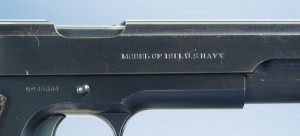
The 1911 pistol was also a hot item to have if you were assigned to the Punitive Expedition of 1916, down Mexico way. Officially known as the Mexican Expedition, and unofficially as the Pancho Villa Expedition, back then they were a lot less squishy about some uses of the language. While a woman’s legs might be called “limbs,” when it came time to kick butt and take names, it was the “Punitive Expedition,” or expedition of punishment. Pancho Villa was the hombre they were out to punish.
Mexico was at the time in turmoil. The Mexican revolution of 1911 had been a mess, and to the disappointment of Pancho Villa (one of the contenders) the US government sided with the Carranza contingent. Villa, having assumed the assurances he’d been receiving would mean he’d be backed as president, was understandably put out. He began attacking American interests along the border, but staying south of the line. On March 6, 1916, he attacked Columbus, New Mexico, and tangled with the 13th US Cavalry. He got his butt royally kicked, losing sixty-seven dead on the scene, and another thirteen who would die later of their wounds.
By March 15, President Wilson had ordered General Pershing to take care of things, and Pershing was already crossing the border. (Today, the first round of press conferences would not have even ended in that period of time.) Taking 4,800 men, Pershing advanced into Mexico without the agreement of the Carranza government, meaning no railway travel. So the US Army used trucks as well as horses and mules for transport and airplanes for reconnaissance. And they packed the new 1911 pistol with them. Well, some did; many old hands still stuck with the Colt SAA.
As a military effort, the expedition did not succeed. The Army did not capture Villa, although in a daring raid, a force led by Lieutenant George S. Patton drove their vehicles right into a small village where Villistas were and captured many, Patton personally killing Julio Cardena, a Villa commander. As a means of stopping the raids, the expedition wasn’t much use. It put the US on temporarily bad terms with the Mexican government, it failed to capture Villa, and it pointed out shortcomings in procedures and equipment in the U.S. Army. But as a live-fire training exercise, it was just what the Army needed before turning toward Europe just a year later.

The 1911 was definitely a harbinger of things to come, and the US Army wasn’t the only service that adopted a big-bore autoloader. Webley & Scott offered the British Army a self-loading pistol in 1913, the Webley & Scott Pistol Self-Loading .455 Mark I. It fired a proprietary cartridge, the .455 Webley Automatic. The .455 WA had a semi-rimmed case, and while slightly larger than a .45 ACP, it could be wrestled into a 1911, a feat Colt quickly accomplished.
The British Army was underwhelmed, but the Royal Air Corps, in need of firearms, adopted it and used it throughout the war. Among its other odd features (an oddly-angled grip and seriously ugly looks) the recoil spring was a massive “V” spring under the right grip panel. Should you ever have and shoot one, and the spring breaks, you are done.
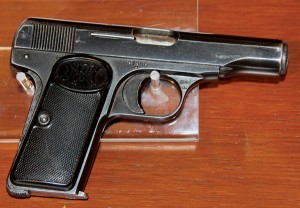
Also, the Webley pistol did not use the magazine follower to lock open when empty. It just knows. Considering the beautiful balance of a British shotgun, and the great feel (if odd looks) of the Webley revolvers, you had to wonder of the designers really had their hearts in the self-loading pistol project.
At the end of June of 1914, the old world came to a screeching halt, and the new world was ushered in by blood. The Europe of today was not the Europe of then. There were France, Germany, and squeezed off to the side, Switzerland. Between them, buffering them from the empires to the West (Russia and Turkey) and Italy, was the Austro-Hungarian Empire. It was a crazy-quilt of nations and nationalities, and sectarian violence was common.
On June 28, 1914, Franz Ferdinand – the Archduke of Austria-Este, Austro-Hungaria, and Royal Prince of Hungary and of Bohemia, and the presumptive heir to the Austro-Hungarian throne – was visiting Sarajevo in Bosnia-Herzegovina on an official function.
Unbeknownst to him, there was a conspiracy to assassinate him as he traveled in his motorcade. The conspirators, armed with hand grenades and pistols, lined the route. Two of the assassins selected that day failed to act, but one – Gavrilo Princep – did, throwing a grenade that missed the Archduke’s car, an enormous Graf & Stift convertible with its top down, but wound ed the passengers of a trailing car.
Princip, having missed his opportunity, went into a local shop. The Archduke, upon finding out one of his party had been injured, wished to pay his respects to the victim at the hospital. The drivers, however, did not get the word of the new destination and drove back along the same path they had taken just before.

Princep looked up to see the missed opportunity coming right at him, again, so he rushed out of the shop. The eye-witness accounts are a mess, and apparently everyone saw something entirely different. Some say he ran to the car; others, that he jumped on the running board of the car. In any case, Princep fired two shots. The Archduke and his wife Sophie were both mortally wounded, and Franz died within a minute. The car sped to the Governor’s residence while the mob beat Princep nearly to death. The Archduke’s wife died ten minutes after arriving at the residence.
All of Europe was spoiling for a fight, and the mass of interlocking treaties almost ensured that everyone would be dragged into it. Most rushed willingly to the conflict. The Austro-Hungarian Empire declared war on Serbia, the Russians stepped up to defend Serbia, and when the Russians mobilized, Germany did so too.
What pistol touched off the first World War? For a long time here in the US it was commonly held that the pistol Gavrilo Princep used was an FN M-1900, in .32 ACP. It was not. It was an FN M-1910, in .380 Auto. The pistol he used is in a Jesuit church in Austria, along with the police reports, transcripts of the trial, and other items associated with the truly history-making incident.
Thus the Model 1911, which played an important role in ending WWI, was created by the same man who designed the pistol that started it: John Moses Browning.
This article is an excerpt from Patrick Sweeney's 1911: The First 100 Years.

Next Step: Get your FREE Printable Target Pack
Enhance your shooting precision with our 62 MOA Targets, perfect for rifles and handguns. Crafted in collaboration with Storm Tactical for accuracy and versatility.
Subscribe to the Gun Digest email newsletter and get your downloadable target pack sent straight to your inbox. Stay updated with the latest firearms info in the industry.

![Best Concealed Carry Guns In 2025 [Field Tested] Wilson Combat EDC X9S 1](https://gundigest.com/wp-content/uploads/Wilson-Combat-EDC-X9S-1-324x160.jpg)


![Best 9mm Carbine: Affordable PCCs [Tested] Ruger Carbine Shooting](https://gundigest.com/wp-content/uploads/Ruger-Carbine-Shooting-100x70.jpg)
![Best AR-15: Top Options Available Today [Field Tested] Harrington and Richardson PSA XM177E2 feature](https://gundigest.com/wp-content/uploads/Harrington-and-Richardson-PSA-XM177E2-feature-100x70.jpg)
